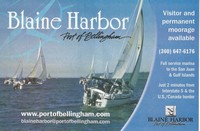MYCBC – Why Join Us › Forums › General Discussion › Lee shore
- This topic has 15 replies, 7 voices, and was last updated 8 years, 6 months ago by
 Darry & Leisa Major.
Darry & Leisa Major.
-
AuthorPosts
-
September 18, 2016 at 4:08 pm #5182
Anonymous
I was just pulling into the fishing fleet off West Van last Sunday when the engine died. For once the marine report underestimated the wind so it was probably 20kt and good size waves. By the time I had tried the motor a few more turns, the boat was heading in a broad reach so the main sail battens stuck in the shrouds as i tried to raise it. I blasted a few sets with the air horn but no one noticed.
I was now about 75 m off Ambleside Beach so dropped the anchor (Danforth) but barely slowed me down. I would guess we were doing about 2.5 knots in wind and sea so I raised the anchor and carried it to the stern hoping to stop run over it but again barely slowed me down.
Then the trusty Macgregor came into its own as I raised the rudders and centerboard. By now a few beachgoers saw what was going on so I had them just hold me off by the bow as the boat came abeam the sea.
I thew every body off the boat immediately. One of the crew had called my buddy who was fishing close by who came in about 2 mins and pulled me off the beach with the rode that was still out there. Once we head to wind I got the sails up and sailed back to Kits where he reattached and towed me in.
I had left three slightly wet, lifejacketed crew in West Van and told them to cab back as the home trip was going to be iffy.
So here are the details and I would appreciate any comments.
1) Engine 2008 70 hp Suzuki 300 hours always winterized and I’d just spent a grand on the VST and fuel pump. It had been running like a top. I have been told the computer has failed??
2) I had checked the weather and had just told everyone we would troll into the harbor to get out of the way.
3) It took no more than 15 mins from the engine dying to getting pulled off the beach so things do indeed go FUBAR real quickly.
4) Big mistake: not having roller furling jib ready to deploy as taught. Although a mistake, I think this would have just sped me into the beach as we were by then so close.
5) By the time I could have called a ‘Securte’ on VHS we were beached. Coast guard hovercraft was actually already down the shore and came by for a look.
6) Apparently if you are moving fast the anchor can plane across a sandy bottom and not set.
7) I was only close to the beach for the fishing.
Altogether I was very lucky so beware the lee shore – I’m Just SayinSeptember 18, 2016 at 5:07 pm #5183Glad to hear you survived without damaging the boat. It must have been very scary to have so little control. I hope that my Rocna anchor would hold better. Maybe I should try tossing it at 2-3 kts and see if it would grab so I would know for sure. A good reminder to keep the headsail available for emergencies. Maybe we should add emergency deployment of head sail to our “Safety Sail” in Blaine. Good luck with the engine. I have no device on that one. If you find a good Suzuki mechanic let me know. I’m still taking mine down to BWY in Washington.
September 18, 2016 at 5:50 pm #5185Anonymous
Gemini,
Have you ever used Bridgeview Marine in Delta; they are Suzuki techs according to Google?September 18, 2016 at 7:25 pm #5186Anonymous
I wonder if additional scope would help the anchor to bite. Might need 10 to 1 before you get the right angle … not sure … just throwing ideas out there.
September 18, 2016 at 8:50 pm #5188I have no information about Bridgeview. Good luck.
September 18, 2016 at 9:06 pm #5189It was our roller furling jib that saved us from grounding when our engine quit off Nanaimo last month. Had we still had the MacGregor with the hank on jib we would likely have been aground.
September 19, 2016 at 8:52 am #5193Anonymous
Thanks for the ideas. I spent a few minutes playing with the anchor when i got back. The flukes on the anchor project out when the shank is pulled up so my thought was I had too much scope out so it just dragged along the bottom. If i could have pulled it up the flukes would have dug in.
Its a topic for discussion.September 19, 2016 at 11:34 am #5195Anonymous
I am sure that Darry will have info to add but as an instructor here are a couple things.
1. You should never leave the dock without some type of sail ready to deploy. Most people rely on the engine as #1 form of propulsion, when in fact it should be the sails as #1 propulsion and engine as a backup if the wind dies. We too much rely on the engine, myself included as the primary source of moving. As you experienced things can go wrong with the engine in a hurry and you are then left to fend. I now never leave the docks without at least the headsail rigged and ready to go, I almost always have the main ready to be hoisted with the cover off and only 1 or 2 sail ties on, and the main halyard attached. If we change our thinking from engine #1 to sails #1 and engine #2 we should always be prepared to go should something happen. a furling headsail takes seconds to deploy and you don’t always need all of it to move, especially if you have over 20 kts of breeze. That goes for passages through passes or currents. “If my engine dies, what is plan B? Always have a plan B” There is nothing wrong with taking into consideration what is the worst that can happen with this situation I am about to get into and how can i mitigate those consequences, that way you can be prepared for the worst.
2. Danforths are really not the greatest of anchors. I have one also, but once in motion they tend to have a hard time setting. I think that a Rocna or manta style anchor would have grabbed but that is to be seen (Rick would love to know the results, perhaps that is something we should try VS. other styles.
3. Wind can be deceiving, something to always keep in mind is that gusts can be up to 40% greater than the wind forecasted. So if the forecast is 15kts the gusts can be up to 21kts. And wave height can be up to double. not to mention if you were over by ambleside (Lionsgate, correct me if I am wrong, but something to always keep in mind) there is a large amount of current coming-out of the inlet. and if you have wind over tide the waves can really start to stand up there. I have been out racing and the standing waves were probably 6-8 feet. Again, these aren’t things that should scare us as long as we know and are prepared for it.
4. A Securite would have been the incorrect VHF call, Securite (or Safety Calls) are for providing information regarding a navigational or meteorological warning. Unless you were considering yourself a navigational hazard. The correct call would have been a Pan Pan call. A Pan Pan or Urgency signal has a very urgent message attached regarding the safety of a vessel or person. It lets the Coast guard know that you have a situation that may become trouble. In your case you may have even been able to call a mayday because your situation did have the potential to become grave or imminent but that is the distinction you would have had to made. I do think that at the end of the day the coast guard probably would’t have been upset with a potential grounding of a vessel in adverse conditions. I have heard maydays called for less. Also the coast guard would have asked vessels in the area to assist, which may have got you help sooner. Remember, it is our responsibility to assist other vessels in distress if and when we can do so without endangering ourselves. Something to remember is that Pan Pan and Securite are to be made to ALL STATIONS. eg. Pan Pan, Pan Pan, Pan Pan, – All stations, All stations, All stations, – This is ……..
You may also want to consider switching out your VHS for a VHF!! I once tried to make a Mayday call on a Betamax and it didn’t turn out well 🙂
All in all, it sounds like you made some great decisions and managed to get out unscathed. But as a learning lesson, what would you have done if you didn’t have a friend close by to pull you off? If you did have sails prepared what would your course be, or what would you have needed to do to get out safely? Hindsight is a great thing, especially if you take the time to learn from the situations. As it seems like you are doing here. Take time and replay the whole scenario in your head and change some of the values (sails, anchor, etc) to see what other possible outcomes could have been and how you would have dealt with those.
Just happy you made it out ok and no one was hurt.
September 19, 2016 at 4:14 pm #5198Great comments Paul,
Obviously lots of good takeaways for all of us to learn from.
One of the points we discuss during both our MYCBC spring and fall MacFoulies during the Dock-Talk is “sail preparedness”.
1) We always preset both main and head sail before leaving the dock, physically unfurl the headsail and raise the main to ensure all running rigging (sheets and halyards) are clear and not fouled.
2) some boats have headsail sock covers. These protect the sail from UV damage and dirt/mold while the boat is at rest, but should never be on the sail while underway for exactly this reason so it’s available for emergency deployment.
3) we also teach during the MacFoulie’s to put a reef in the main sa and take the mainsail cover off (if going out in inclement conditions or anticipating problems) so that the sail is ready to lift and is not over canvassed. (Too much sail out)
4) we also conduct crew over board drills under full sail with the assumption that our engine doesn’t work.One great thing about a MacGregor is the shallow draft and the ability to pull up rudder(s) and keel so it can be beached, but I would not rely on this as an emergency option as beaches on the West Coast are rarely as soft and flat as Ambleside, a rocky lee shore might do damage to our thin fibreglass hills in short order.
I agree that Sailing out of trouble should’ve been the number one option, then deploying the anchor should’ve been number two – surprised your anchor didn’t catch even at 2 kn especially in mud and sand where you were.
I don’t think anyone truly expects to be in a serious or life-threatening situation, so when it is occurring it may not be recognized or seem as serious as it might become. For most of us, remaining calm and not panicking and processing emergency thinking is usually not a natural reaction, and is something that needs to be thought out ahead of time, so practising safety manoeuvres is the best way to control behaviour and increase positive results if a situation ever does arise – and is a reason our club focusses on some of these issues at the MacFoulies and the Regatta-Safety Sail and all year your long talking together like this.
Darry
September 21, 2016 at 4:48 pm #5206Glad to hear that everyone is safe.
Check POCO Marine, they are Suzuki techs.
The DF70 is a bulletproof engine it has a limp back home mode that should allow you to motor at about 6 knots.
There should be something very wrong with your motor.
Also consider a small cheap trolling motor as a backup.September 23, 2016 at 1:06 pm #5207Anonymous
I know the video above on anchors has been shared before but it is really interesting. It seems like having anchors skip along the bottom is very commmon so relying on an anchor to stop you if you are moving is risky.
The link above is modifying an existing anchor to make it reset better.
I am thinking about drilling some holes in my Rocna!September 27, 2016 at 1:19 pm #5211Anonymous
That is interesting, as I was watching the second video, and he was talking about the mud sticking, I was thinking about Ginsu knives and how they have the dimples to stop food from suctioning onto the blade and low and behold he drills holes in the thing to stop the mud from sticking!!
Very Interesting video
September 27, 2016 at 1:19 pm #5212Anonymous
That is interesting, as I was watching the second video, and he was talking about the mud sticking, I was thinking about Ginsu knives and how they have the dimples to stop food from suctioning onto the blade and low and behold he drills holes in the thing to stop the mud from sticking!!
Very Interesting video
September 27, 2016 at 2:26 pm #5213Anonymous
Rick and I were chatting about this during the Harrison trip. He mentioned that Glen might have used Wax to help prevent mud from sticking. Added waxing the anchor to my winter todo list. It is worth a shot. Glen, if you read this, can you provide any more info?
September 28, 2016 at 3:39 pm #5215Wax the anchor? What a great idea!
Our stainless steel anchor rarely comes to the surface with mud-muck on it because I think the finish is so slippery compared to a galvanized finish that is more rough to the touch.
I’ve always polished the crap out of our anchor to make it shiny, maybe all this time making it more slippery and muck resistant and didn’t even know it 🙂
Waxing the anchor … what a great idea!
-
AuthorPosts
- You must be logged in to reply to this topic.













